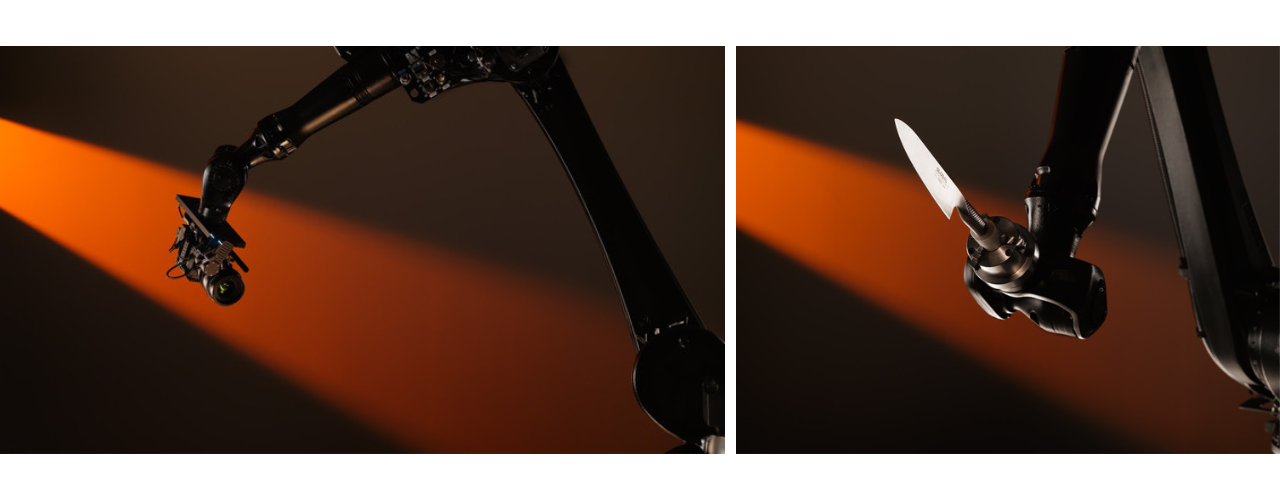AOP Member Jason Butcher shares details of robot arm use in his studio.
I’ve been shooting motion of products and people for over twenty years. Subjects such as cameras, TV’s, laptops, printers, scanners, even shower controllers demand smooth moves that can transition well in the edit. Reducing jerks, jitters and varying speed camera moves by hand has always been a challenge when you’re close in on a product, plus when using existing camera grip these moves tend to be limited to straight lines, either up/down, left/right/ forward/reverse and maybe some angle on those with some extra rigging. I’ve tried many different pieces of equipment to create moves including using my studio stand, which did a good job but as they aren’t built for the job they have their limitations. I realised early on that I wanted to create moves like I had seen on TV and in the movies and reading up on the subject led me to tools such as Milo, a multi-motored beast of a machine capable of running moves through 3D space – just what I wanted. Problem was, and this was back in the noughties, they were £250K to buy and around £10K a day to hire, which was well out of my budget, so I carried on doing what I was doing and refining it as far as I could.
Move on a few years, around 2017, I became aware of robotic arms, like you’d see on a car production line, being used in the movies, pioneered by an American company Bot & Dolly; either to carry a camera or be used as a model mover. I believe they were used in entertainment parks before that where they’d carry people strapped in seats as part of a movie experience ride. It showed me that there were alternatives out there, but at what cost? Now high speed robotic arms aren’t cheap and because it’s all so cutting edge getting them to work for photography isn’t easy and they need a lot of bespoke work if you want to integrate them with other kit, so they still require a decent investment in time and money (plus it really helps to find a graduate of a robotics degree to help with the electronics!) but the pay off is I can create moves like I never could before and not at the price of the other technology I mentioned 🙂
The robot arm can be controlled to move through 3D space smoothly and fluidly with gentle curves or follow a geometric shape more rigidly, say text or a logo for example, plus it can move fast, enough to follow the action on a high speed shot –think 1000fps– in order to give the footage an added dimension rather than a static shot that you usually see. It can run any move repeatedly with high accuracy, so multiple takes with differing product/set/lighting can be layered in the edit to create seamless sequences that blend the takes.
It can be used for stills too. Moving the camera between different angles is fast and repeatable, plus we can couple it to a turntable that’s computer controlled, taking the effort out of multi-product / multi-angle shots, or can be used creatively; just think what you can do with long exposures.
On a visual engineering note, we can apply triggers on the robot arm move timeline, the same as what we’d do when a turntable is involved like in the stills example, to control other tools such as actuators that run off compressed air to push, pull, fling etc. or motors that might control cutters or conveyors, the list is endless, and all timed to perfection.
The arm needn’t carry just cameras, it can be used as a model mover which could include the product, a light, a prop, a background – all repeatable too. Animations using stop motion techniques are achievable and recently film makers in Australia have coupled live shooting of backplates with robots, and have even bolted one robot to another to achieve the moves they’ve wanted(!) and then blended in post with digitally created characters. The arm can be used on virtual reality productions and hybrid systems of real world footage matched with CG backplate imagery that moves in sync; this negates the need for a large LED volume.
Some moves would benefit from being arranged in pre-production and it can be a more cost effective option to working on them on production days, plus it gives the ability to test the shot beforehand. We can work with your 3D data or create our own to help design moves.
It’s been a really fun project to be involved with, despite the huge amount of time and effort, though it did help to keep us occupied during lockdown. It’s reaping its rewards now that clients are seeing the benefits of using the arm in their shoots. It’s not the be all and end all, more another tool in the box to choose when the job requires it.
If you have a project that could benefit from the addition of a robotic arm but aren’t sure about the capabilities please do get in touch and I can talk it through with you: +44 1252 333159.
Jason Butcher
